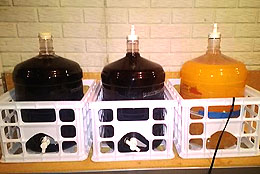 I’ve recently started making wine again after about ten years away and, of course, the changes in wine kits over that time are striking! Specifically, I’ve started three different kits from different manufacturers and followed each set of instructions accurately. All three completed fermentation (as measured by hydrometer), but the first one was visibly vigorous with a lot of foaming, the second just bubbled a bit and completed in only three days, and I had to look carefully at the third to see the tiny bubbles rising up the sides of the carboy. Why did these fermentations look so different, was one “better” than the others, and were these differences intentional by the manufacturers?
I’ve recently started making wine again after about ten years away and, of course, the changes in wine kits over that time are striking! Specifically, I’ve started three different kits from different manufacturers and followed each set of instructions accurately. All three completed fermentation (as measured by hydrometer), but the first one was visibly vigorous with a lot of foaming, the second just bubbled a bit and completed in only three days, and I had to look carefully at the third to see the tiny bubbles rising up the sides of the carboy. Why did these fermentations look so different, was one “better” than the others, and were these differences intentional by the manufacturers?
Name: Dave S.
State: Ohio
—–
Hello Dave,
Fermentations will more often then not will vary in both their appearance and speed, even when they are sitting side by side. Some of the reason for this is that there are just so many variables involved with a wine fermentation.
From the set of nutrients in one fermentation verses another, to the fact that one is slightly closer to the basement window than the other — all of these little things can make a difference in the way a wine ferments. And, the list of these little things (variables) goes on and on… They affect the fermentation time, and they effect the bubble rate.
But having said this there are two factors that trump all these variables: 1) what is being fermented, and 2) the type of wine yeast being used.
Different juices foam differently. They also vary in the set of nutrients they provide for the fermentation. These nutrients can directly affect the wine yeast’s ability to ferment. Some wine yeast will foam more than others. It just part of their character. Some yeast will also ferment harder than others, given the same set of fermentation variables.
Now for a final word. None of this matters. How much the fermentation foams or how quickly it finishes will have no direct effect on the final outcome of the wine. Whether it is 3 days or 10 days, it will result in the same wine when matured 6 months down the road.
What does matter is that the best wine yeast for the particular job at hand is used. That is why these kit manufactures will use an array of different yeast strains across their line of wine kits. Some work better with certain wine juices then others. Some of it is because of the flavor nuances the wine yeast provides. Some of it is because it is better at fermenting the situation at hand. Here is a yeast profile chart that may help you to understand this a little more clearly.
Thanks for the great question and happy wine making,
Customer Service at E. C. Kraus
———————————————————————————————————
Ed Kraus is a 3rd generation home brewer/winemaker and has been an owner of E. C. Kraus since 1999. He has been helping individuals make better wine and beer for over 25 years.
